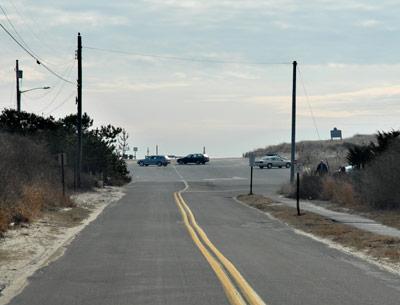Change Coming at Indian Wells

The procedures and structures implemented last year to control congestion and rowdy behavior at Indian Wells Beach in Amagansett will be modified for the coming summer, East Hampton Town Councilwoman Sylvia Overby told the Amagansett Citizens Advisory Committee at its meeting on Monday.
With few members in attendance and some of the committee’s recent concerns off the table for now — chief among them a 7-11 convenience store and the proposed 555 housing development — Ms. Overby updated the gathering on efforts to maintain order at the popular beach.
Her remarks summarized a report she had delivered to the town board at its March 4 meeting, on a draft proposal developed by a committee including the town police chief, Michael Sarlo; Ed Michels, the harbormaster, Diane McNally, clerk of the town trustees, Marguerite Wolffsohn, the planning director, Kim Shaw, director of natural resources, Tom Talmage, a planning department engineer, Stephen Lynch, the highway superintendent, and John Ryan Sr. and John Ryan Jr., the town’s lifeguard trainer and lifeguard chief, respectively.
Last year Ms. Overby, formerly the town board’s liaison to the committee, told the group of a preliminary plan to install an attended booth at the intersection of Indian Wells Highway and Bluff Road. Ultimately, the booth was situated at the entrance to the beach’s residents-only parking lot. The attendant was tasked with turning vehicles away when the lot became full, except for cars with resident permits or Amagansett Beach Association stickers.
The plan succeeded in reducing both congestion and danger to pedestrians, and, to a lesser extent, discouraging people from carrying coolers and kegs to the large alcohol-fueled gatherings for which the beach has become widely known.
Under the new proposal, the booth will be moved up toward Bluff Road, Ms. Overby said, which will allow additional parking on the west side of Indian Wells Highway, where there is now a sidewalk. A five-foot-wide sidewalk on the east side of the road will replace it, and link with the sidewalk on Bluff Road. The changes will allow approximately 22 additional parking spaces, Ms. Overby said. Handicapped spaces will increase from two to five.
The booth will be situated at a cul-de-sac turnaround, to be put in place on Indian Wells Highway about 100 feet south of the Bluff Road intersection. Nonresident vehicles, including taxis and buses, will have to discharge passengers at that point.
Kieran Brew, the committee’s chairman, said that the longer distance nonresident beachgoers would now have to walk “might be the game-changer” in discouraging them from carting cases or kegs of beer to the beach.
The changes are also expected to provide a safer environment for those on foot in the parking lot. Until the attended booth was installed last year, buses, taxis, and private vehicles crowded into the narrow lot, picking up and dropping off bathers or idling while waiting for a parking spot.
The restroom will also be reconstructed, with a new cupola allowing needed ventilation. A storage area within the structure will shrink to allow additional toilets and sinks, as well as a second outdoor shower. The deck will be rebuilt, and a shed addition will be used to store lifeguard equipment.
New garbage cans will be installed at the beach, and regulations will be consolidated onto new signs, Ms. Overby said.
The town board has authorized a $250,000 bond to finance the entire project, which Ms. Overby said she hoped would be completed by June. “I think sprucing up this beach is really important,” she concluded.
“Thank you very much,” said Joan Tulp, a committee member, noting that residents have been asking for some of the improvements Ms. Overby detailed.
The committee also considered the consumption of alcoholic beverages on town beaches, focusing on the hundreds-strong gatherings at Indian Wells. At the town board’s March 4 meeting, Chief Sarlo had reported better behavior on the beach last year and a reduction in summonses issued by Marine Patrol personnel. His department had “put quite a bit of effort” into increased oversight, he said, citing one or two Marine Patrol officers assigned to the beach, a traffic control officer onsite most or all of the day, and the booth attendant.
“I would personally like to go out for a public hearing,” Ms. Overby said on Monday, “to see where the public stands on alcohol on lifeguarded beaches during lifeguarded hours.” Town attorneys, she said, have indicated that a ban on alcoholic beverages within a certain distance from lifeguarded areas can be imposed on individual beaches.
With reporting by Joanne Pilgrim
